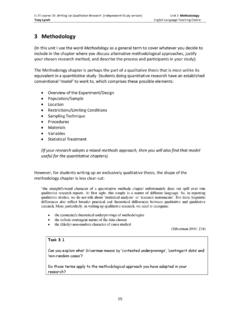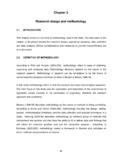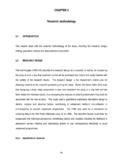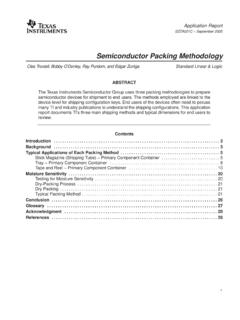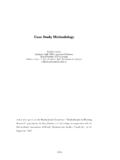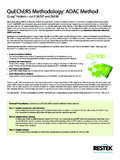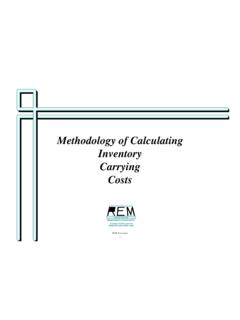Transcription of A comprehensive methodology to qualify the …
1 a comprehensive methodology to qualify the reliability of GaN productsSandeep R. BahlGaN reliability , Devices & Modeling Manager, High Voltage Power SolutionsTexas InstrumentsA comprehensive methodology to qualify the reliability of GaN products 2 texas instruments : March 2015 IntroductionThe industry takes the reliability of silicon power transistors for granted due to over thirty years of experience and continuous improvement. This longstanding experience has resulted in a mature qualification methodology , whereby reliability and quality are certified by running standardized tests.
2 These tests originated from detailed work on the understanding of failure modes, their activation energies and acceleration factors, and the development of a statistical and mathematical framework to extrapolate lifetimes, failure rates and defectivity. This qualification methodology has been proven out now that several generations of silicon parts have been run for their true lifetimes under actual-use transistors, however, are a more recent development. RF GaN HEMTs on more expensive silicon carbide substrates have become widely used in wireless base stations with proven reliability [1].
3 The power GaN HEMT, although based on similar fundamentals, has added features to enable higher voltage handling. It is grown on a silicon substrate and uses silicon fabrication-compatible materials to lower cost. Additionally, it needs to be an enhancement-mode (e-mode), or normally-off device, for fail-safe reasons. There are three leading architectures: 1) depletion-mode (d-mode) insulated gate GaN HEMT cascoded with an e-mode Si FET; 2) e-mode insulated gate GaN HEMT; and 3) p-doped, e-mode junction-gate GaN HEMT. These have different failure modes from each other, and from silicon FETs, which brings up the question of how to qualify them.
4 The standard silicon-based qualification recipe is a worthy quality and reliability milestone, but it is not clear what it means for GaN transistors in terms of device lifetime, failure rates and instruments is an industry leader in semiconductor technology with longtime experience in bringing reliable semiconductor products to market, including non-silicon technologies like ferroelectric random access memory (FRAM). We are well-suited to bring reliable GaN products to market through GaN-relevant qualification methodology and application-relevant testing. TI is designing a comprehensive quality program based on GaN fundamentals and application-relevant testing to provide reliable GaN material properties of gallium-nitride (GaN) enable an exciting and disruptive new power switch the power GaN high-electron mobility transistor (HEMT).
5 This HEMT is a field-effect transistor (FET) with much lower on-resistance. It can switch faster than an equivalently-sized silicon power transistor. These benefits are making power conversion more energy and space efficient. GaN can be grown on silicon substrates, which allows the use of silicon manufacturing capability and lower cost. As with new technologies, however, reliability needs to be proven. GaN device qualification is the subject of this comprehensive methodology to qualify the reliability of GaN products 3 texas instruments : March 2015 Standard qualification methodologyThere are two standards bodies whose qualification methodologies are in widespread use for qualifying silicon power devices: Joint Electron Device Engineering Council (JEDEC); and Automotive Electronics Council (AEC) [2, 3, 4, 5].
6 These standards specify many tests which may be classified into three categories: electrostatic discharge (ESD), package, and discharge requirements are imposed by handling, so the ESD qualification is not expected to change. Packaging tests are expected to be similar to those done for silicon, with failures being driven to root cause to highlight unexpected failure mechanisms. The similarity arises because the issues of package stress, bonding surface interactions, and so on, are common since the back-end processing used historically with silicon is also used with GaN. The device category, however, is new and consequently of particular importance.
7 The following paragraphs examine the standard silicon qualification methodology and describe how it may be adapted to silicon qualification the standard stress is run for 1000h, at a junction temperature of at least 125 C. An activation energy of eV is assumed, giving a temperature acceleration factor of [2]. This makes a 1000h stress at a junction temperature (Tj) of 125 C equivalent to nine years of use at Tj=55 C. Devices are qualified at their maximum operating voltage. For discrete power FETs, this is usually chosen to be 80 percent of the minimum breakdown voltage specification.
8 This means that there is no voltage acceleration built into the qualification test condition and acceleration is achieved by temperature alone. This has important implications for power devices, since Tj is higher than 55 C, typically above 75 standard also specifies that three lots, each with 77 parts, be stressed with no failures. A criteria of zero failures out of 231 means that the lot-tolerant percent defective (LTPD) value is one [2]. This means that you can state with 90 percent confidence that less than one percent of the parts in a lot are defective under the extrapolated stress condition.
9 In other words, nine years of use at Tj=55 C, biased at the maximum operating voltage. The initial maximum failure in time (FIT) rate of about 50 FITs at Tj=55 C is also established from the result of zero fails out of 231 units using the activation energy of eV [6].There is a dynamic test in addition to the static tests, however. It is very loosely defined as the devices may be operated in a dynamic operating mode [3]. It is left to the manufacturer to define the testing. The absence of prescribed testing is due to the difficulty of specifying a test that corresponds to the wide range of ever-evolving applications and technology.
10 A prescribed stress test may not correlate appropriately to the actual-use environment and may either produce false failures or fail to accelerate valid failure mechanisms [7]. For silicon FETs, credibility in the qualification methodology has been established by many years of actual usage. In contrast for new technologies like GaN, it falls to the device manufacturer to establish that their dynamic testing is predictive of actual use. Therefore, it is important to develop application-relevant stress testing where reliability can be validated under actual-use , there is concern that GaN is not avalanche robust.










